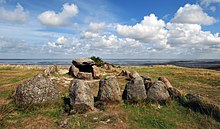
A passage grave or passage tomb consists of one or more burial chambers covered in earth or with stone, and having a narrow access passage made of large stones. These structures usually date from the Neolithic Age, and are found largely in Western Europe. When covered in earth, a passage grave is a type of burial mound which are found in various forms all over the world. When a passage grave is covered in stone, it is a type of cairn.

A megalith is a large prehistoric stone that has been used to construct a structure or monument, either alone or together with other stones. There are over 35,000 in Europe alone, located widely from Sweden to the Mediterranean sea.
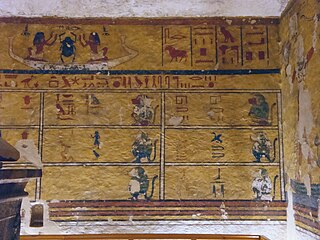
A chamber tomb is a tomb for burial used in many different cultures. In the case of individual burials, the chamber is thought to signify a higher status for the interred than a simple grave. Built from rock or sometimes wood, the chambers could also serve as places for storage of the dead from one family or social group and were often used over long periods for multiple burials.
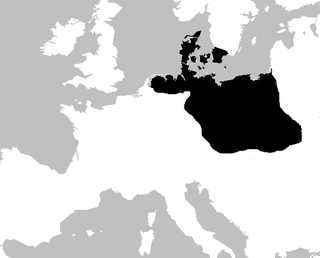
The Funnel(-neck-)beaker culture, in short TRB or TBK was an archaeological culture in north-central Europe. It developed as a technological merger of local neolithic and mesolithic techno-complexes between the lower Elbe and middle Vistula rivers, introducing farming and husbandry as a major source of food to the pottery-using hunter-gatherers north of this line. It was preceded by Lengyel-influenced Stroke-ornamented ware culture (STK) groups/Late Lengyel and Baden-Boleráz in the southeast, Rössen groups in the southwest and the Ertebølle-Ellerbek groups in the north.

The Sieben Steinhäuser is a group of five dolmens on the Lüneburg Heath in the NATO training area of Bergen-Hohne, in the state of Lower Saxony in northern Germany. The stones are considered to be part of the funnelbeaker culture. The gravesite was granted protected cultural monument status in 1923.

Denghoog is a Neolithic passage grave dating from around 3000 BC on the northern edge of Wenningstedt-Braderup on the German island of Sylt. The name Denghoog derives from the Söl'ring Deng (Thing) and Hoog (Hill).
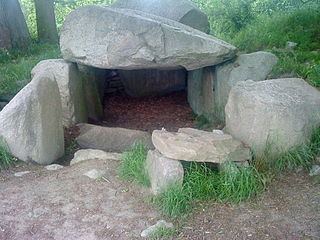
The Lancken-Granitz dolmens are a group of seven megalith tombs in the Lancken-Granitz municipality on Rügen, northern Germany. Erected during the middle Neolithic, when they were used by the Funnelbeaker culture, at least some were in use until the early Bronze Age. Three of them are encircled by solitary rocks forming either rectangles or a stone circle, one has a solitary "guardian stone" on its eastern side.

In the area of present-day Mecklenburg-Vorpommern, Germany, up to 5,000 megalith tombs were erected as burial sites by people of the Neolithic Funnelbeaker (TRB) culture. More than 1,000 of them are preserved today and protected by law. Though varying in style and age, megalith structures are common in Western Europe, with those in Mecklenburg-Vorpommern belonging to the youngest and easternmost—further east, in the modern West Pomeranian Voivodeship of Poland, monuments erected by the TRB people did not include lithic structures, while they do in the south (Brandenburg), west and north (Denmark).

The Goldbusch is a great dolmen, a type prehistoric grave site, that lies between Altensien and Moritzdorf on the German Baltic Sea island of Rügen. The megalithic tomb with Sprockhoff No. 508 was built between 3500 and 2800 B. C. in the New Stone Age as a megalithic site of the Funnelbeaker culture (TBK).

The great dolmen or grand dolmen is a type of megalithic site of the Funnelbeaker culture (TBK) that occurs in Nordic megalith architecture, primarily in the east of what is now German Mecklenburg-Vorpommern, and which has two different types of entrance. Neolithic monuments are features of the culture and ideology of Neolithic communities. Their evolution and function act as indicators of social development. The type of site, called Stordysse in Danish, does not follow the criteria listed below. In Germany, dolmens with three or more capstones are described as great dolmens and are divided into:

Nordic megalith architecture is an ancient architectural style found in Northern Europe, especially Scandinavia and North Germany, that involves large slabs of stone arranged to form a structure. It emerged in northern Europe, predominantly between 3500 and 2800 BC. It was primarily a product of the Funnelbeaker culture. Between 1964 and 1974, Ewald Schuldt in Mecklenburg-Western Pomerania excavated over 100 sites of different types: simple dolmens, extended dolmens, passage graves, great dolmens, unchambered long barrows, and stone cists. In addition, there are polygonal dolmens and types that emerged later, for example, the Grabkiste and Röse. This nomenclature, which specifically derives from the German, is not used in Scandinavia where these sites are categorised by other, more general, terms, as dolmens, passage graves and stone cists . Neolithic monuments are a feature of the culture and ideology of Neolithic communities. Their appearance and function serves as an indicator of their social development.

The simple dolmen or primeval dolmen is an early form of dolmen or megalithic tomb that occurs especially in Northern Europe. The term was defined by archaeologist, Ernst Sprockhoff, and utilised by Ewald Schuldt in publicising his excavation of 106 megalithic sites in the north German state of Mecklenburg-Vorpommern. The simple dolmen emerged in the early days of the development of megalithic monuments of the Funnelbeaker culture (TBK) and around 3,500 BC they appeared across almost the entire region covered by the stone cult structures of Nordic megalith architecture, but not in the Netherlands, in Lower Saxony west of the River Weser nor east of the River Oder and only once in Sweden.

A rectangular dolmen, extended dolmen or enlarged dolmen is a specific type of megalith, rectangular in shape, with upright sidestones and, usually, two capstones. The term rectangular dolmen was coined by Ekkehard Aner and is used especially in the German state of Schleswig-Holstein, where dolmens with this type of ground plan primarily occur. A more precise term, however, is extended dolmen, used by Ewald Schuldt and Ernst Sprockhoff, because these types of dolmen also occur with trapezoidal ground plans.

The polygonal dolmen is a visually very attractive megalithic architectural structure and is therefore often depicted as the archetypal dolmen. It is encountered especially frequently in the north of the Danish island of Zealand, in the Swedish province of Bohuslän and on the Cimbrian Peninsula, for example, at Troldkirken in Jutland. In Schleswig-Holstein, there are 11 examples. In Lower Saxony, Mecklenburg-Western Pomerania and Saxony-Anhalt (Lüdelsen) they appear are only occasionally.

The unchambered long barrowearthen long barrow, non-megalithic long barrow or non-megalithic mound, is a type of long barrow found across the British Isles, in a belt of land in Brittany, and in northern Europe as far east as the River Vistula. The term "unchambered" means that there is no stone chamber within the stone enclosure. In Great Britain they are often known as non-megalithic long barrows or unchambered long cairns.

A megalithic entrance is an architectonic feature that enables access to a megalithic tomb or structure. The design of the entrance has to seal the access to the cultic structure in such a way that it is possible to gain access to the interior again, even after a long time, in order to perform rituals. To that end, the practitioners of Nordic megalith architecture, the Wartberg culture and Horgen culture, used several variants, that are also found in other megalithic regions in identical or slightly modified form.

The various types of megalithic monuments in northeastern Germany were last compiled by Ewald Schuldt in the course of a project to excavate megalithic tombs from the Neolithic Era, which was conducted between 1964 and 1972 in the area of the northern districts of East Germany. His aim was to provide a "classification and naming of the objects present in this field of research". In doing so it utilised a classification by Ernst Sprockhoff, which in turn was based on an older Danish model.

The Necropolis of Soderstorf is a prehistoric cemetery in the valley of the Luhe river valley near Soderstorf in the Lüneburg district of Lower Saxony, Germany. The site was used for more than 2000 years. It includes a megalithic tomb, a tumulus tomb, a stone circle, paving stones, funerary urns and a flat grave.
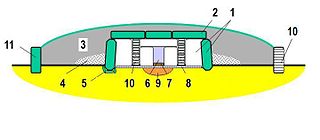
A threshold stone or sill stone is a rectangularly dressed stone slab that forms part of the entrance of megalithic tombs of the Funnelbeaker culture, normally those with a passage. The red sandstone slab, up to 0.1 metres thick, was buried in the ground to a depth of 0.2 metres at the entrance to the chamber. Cultural sites of other types, such as Domus de Janas, also have a clear partition between the passage and the ante-chamber or main chamber.
